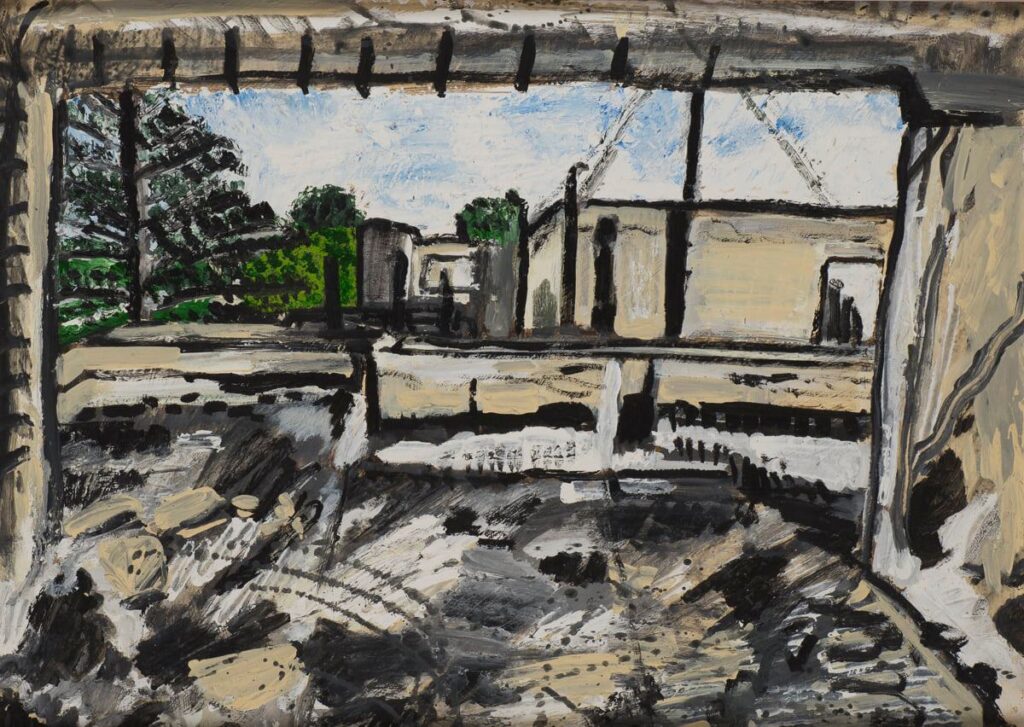This painting by David Reeb (view in Tel Aviv, acrylic on plywood, 60 x 80), is one of the first in my collection. I have had it for 15 years now. It “came” into my possession when I was just a student at “Bezalel” (!) in a somewhat unusual way and above all – thanks to the city of Jerusalem itself, which rained the painting to me from the skies, albeit indirectly. And this is the story:

The year is 2005 and I am a third-year student in the visual communication department at Bezalel Academy in Jerusalem. In between the exercises, submissions and student life I also worked (for pocket money, a few hours a week) for a well-known Jerusalem art dealer with an excellent eye and an even more excellent sense of humor, in a gallery that was then located in the city, in a hotel in front of France Square. Although sales were not and still are not my strong suit, I had a vast amount of knowledge that he liked, and that’s how it turned out that I spent almost 3 years among hoards of valuable and beautiful art works that I would never be able to afford: paintings by Ludwig Bloom, Moshe Castel, Shmuel Haruvi, Reuven Rubin, Nahum Gutman and “Bezalel” items, which came and went at a dizzying pace. Needless to say, that to work with these magnificent pieces, to hold and touch them by the hand, is the real art school of life itself, with endless fieldwork that was also great fun.
It was a rainy Jerusalem morning, and I was walking to my regular ride to school with the folder case that every VC student carries around. Suddenly it appeared in front of me, in the pouring rain. The moment I saw that canvas, which was already soaked in water from the rain, I froze. It was framed in an old plaster frame with moldings, which I immediately recognized as a style common in Israeli homes during the 1950s. I took another second to get there and another second to turn the frame over, realizing that I was holding a typical oil painting from the 1940s by Shmuel Haruvi (whose prices soared to thousands of dollars in the early 2000s) depicting Jerusalem and olive trees, intact, signed, and in shocking condition.
I grabbed it and flew back home in the heavy rain, to the rented apartment on Keren HaKeyemet Street, while texting with my other hand to Hagit Antebi Zohar that I am skipping the first class and that they shouldn’t come pick me up for a ride. I hereby testify, that it was the one and on only time I had deliberately skipped a lesson in Bezalel.
I arrived home out of breath, dried the painting with a towel and cleaned it as best I could from the slime and mud that had soaked into it. Actually, at first I wasn’t particularly worried, because oil paintings are fairly waterproof, and those who are knowledgeable also know that (proportionate) wetting of canvas helps even the re-stretching of the painting on the frame. But to my dismay, as the painting dried completely and the dirt was removed, I realized that it was already a ruined, peeling painting, in which many details of the Jerusalem landscape were missing. I was struck by a terrible double disappointment; having both lost an important class taught by Adi Stern at “Bezalel”, and the nice financial reward for an original oil painting by Shmuel Haruvi, which disappeared between my hands holding the towel. I considered myself as a pathetic lunatic and, above all, horribly stupid.
*
In those days, the gallery where I worked, which as recalled specialized in “classic” and bourgeois Israeli works of art with good taste, actually got this painting by David Reeb. It was stuck there like a complete foreigner, with his tough Tel Aviv aggressive brushwork and aesthetics, among all the Rubins, Nahum Gutmans and Ludwig Blums who were hanging around in golden frames. After a short thought, I mustered up the courage and carried to the gallery the poor remains of what was left of my Shmuel Haruvi painting (on which the signature was intact and correct, and that’s what was really important) – I showed it to the owner of the gallery, and we exchanged the paintings immediately.
David Reeb’s work has been with me since then.
And what happened to Shmuel Haruvi’s destroyed and peeling painting you ask? It was sent to the dedicated care of a professional restaurateur, restored, filled with color, life and romantic Jerusalem landscapes, and sold within a few weeks for several thousand dollars to American Jewish tourists from abroad.